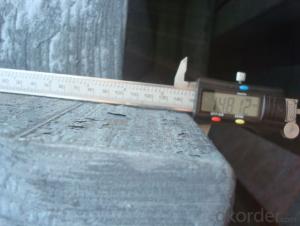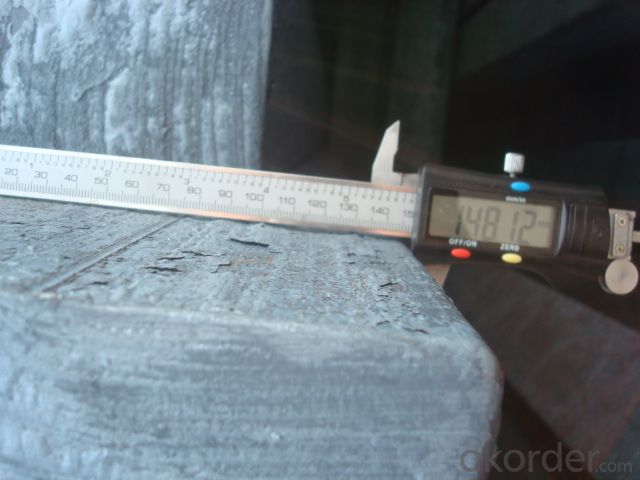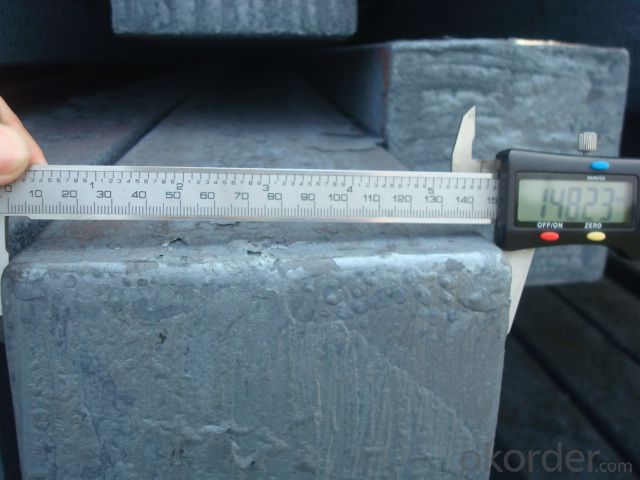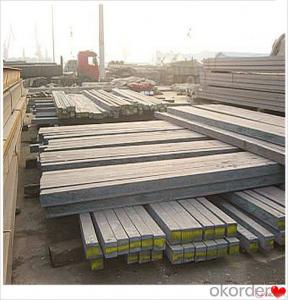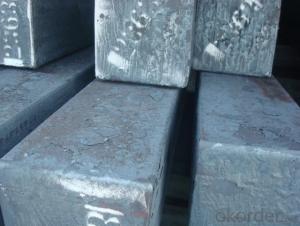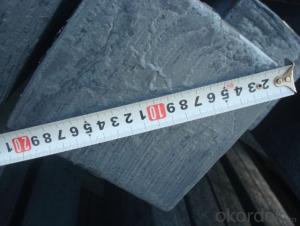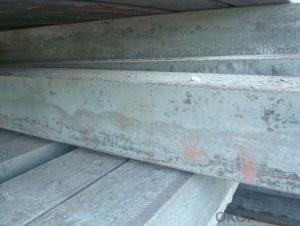Steel Bloom Manufactured by Blast Furnace
- Loading Port:
- Tianjin
- Payment Terms:
- TT OR LC
- Min Order Qty:
- 2000 m.t.
- Supply Capability:
- 100000 m.t./month
OKorder Service Pledge
OKorder Financial Service
You Might Also Like
Steel Bloom Manufactured by Blast Furnace
1.Structure of Steel Bloom Manufactured by Blast Furnace
Steel Bloom Manufactured by Blast Furnace is the raw material of all kinds of steel mill. Billet section of square, round, flat, rectangular and abnormity, etc Several, mainly related to shape of rolled products. Simple rolled section steel, choose cross section of square billet or rectangular billet. rolling The sector products such as flat steel, Angle steel, select the rectangular billet or slab. Had better profiled billet when production beams, channels, and in rolling process Lines and improve the yield. The raw material of round billet is the production of seamless tube.
2.Main Features of Steel Bloom Manufactured by Blast Furnace.
Steel Bloom Manufactured by Blast Furnace section size should meet the requirements of rolling deformation and finished product quality, but also roll strength and biting condition of restrictions. General steel Billet section height H. And the roll diameter D The ratio of the ( namely H/D) Should be less than or equal to zero 0.5 . Length of steel billet by finishing temperature, Rolling time and the length of the product Or times ruler. When heated too long accident prone to bump the furnace wall of steel, too short, furnace bottom utilization rate is not high, influence the heating furnace production. For the production Choose a variety of steel and steel billet, should consider the affinities of billet, as far as possible in order to improve the productivity of the roughing mill, simplify the stock management of workshop.
3. Steel Bloom Manufactured by Blast Furnace Images
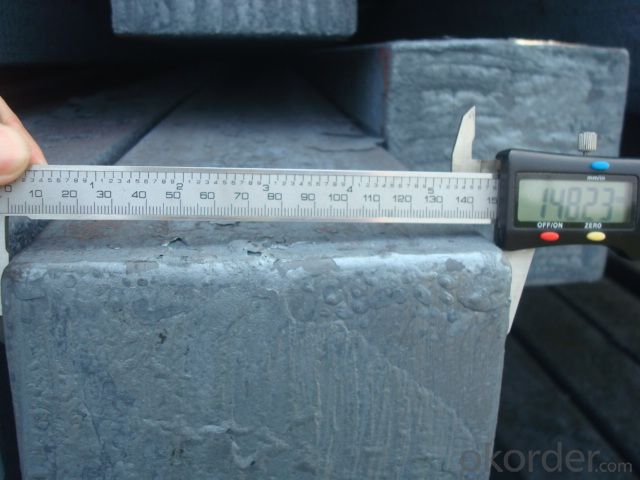
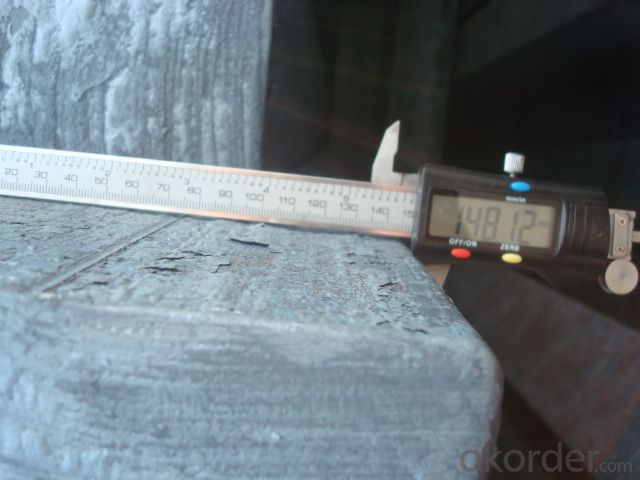
4. Steel Bloom Manufactured by Blast Furnace Specification
Steel Bloom Manufactured by Blast Furnace rolled steel, after processing can be used for mechanical parts, forging parts, processing all kinds of steel, steel Q345B channel steel, wire rod is the role of the billet. Steel billet is used in the production of semi-finished products, generally cannot be used directly for the society. Steel billets and steel are strictly divided into standard, cannot decide to whether the business enterprise of the final product, and according to unified standards to perform the whole society. Typically, billet and the steel is relatively easy to distinguish, but for some steel billet, and have the same specification and same steel purposes (such as rolling tube billet), whether can be used for other industries, whether through steel processing process, whether through a finished product rolling mill processing to distinguish
Material standard The editor Range of thickness: 150-240 - mm + / - 5 mm width range: 880-1530 - mm + / - 20 mm Length: 3700-10000 - mm + / - 500 - mm Cross-sectional size: 64 * 64; 82 * 82; 98 * 98; 124 * 124; 120 * 150; 152 * 164; 152 * 170 mm Length: 9000 mm Section of tolerance: billet: 1.0 + / - 2.0-1.0 + / - 1.0 mm slab: width: + / - 2.0 mm thickness: + / - 3.0 mm The length tolerance: + / - 200 mm Section diagonal tolerance: 3.5-8.0 MM Billet section size protrusions requirements: < 1242 mm, do not allow; > = 1242 mm, < = 2 mm 1242 mm, < = 3 mm Beheading (shear) extension deformation: < 1242 mm billet: no control; The slab: < = 15 mm Surface tilt: no more than billet section 0.1 Bending: every 1 m length is not more than 10 mm The distortion: length < = 5 m, < = 11. ; The length of the < = 7.5 M, < = 5. Material % 3 sp/PS chemical composition: C Mn Si S P
5.FAQ of Steel Bloom Manufactured by Blast Furnace
We have organized several common questions for our clients,may help you sincerely:
①How about your company?
A world class manufacturer & supplier of castings forging in carbon steel and alloy steel,is one of the large-scale professional investment casting production bases in China,consisting of both casting foundry forging and machining factory. Annually more than 8000 tons Precision casting and forging parts are exported to markets in Europe,America and Japan. OEM casting and forging service available according to customer’s requirements.
②How to guarantee the quality of the products?
We have established the international advanced quality management system,every link from raw material to final product we have strict quality test;We resolutely put an end to unqualified products flowing into the market. At the same time, we will provide necessary follow-up service assurance.
③How is the packaging and delivery?
Loose by Vessel and the delivery term is based on the the quantity and our factory’s schedule then.
- Q: How are steel billets used in the manufacturing of power plant equipment?
- Due to their exceptional strength and durability, steel billets play a vital role in the production of power plant equipment. These billets serve as the primary material from which various parts and components necessary for power plant machinery are shaped and formed. One significant application of steel billets in power plant equipment manufacturing is the fabrication of turbine blades. These blades are exposed to high temperatures, immense pressures, and rotational forces. Steel billets are carefully chosen for their mechanical properties, such as high tensile strength and resistance to corrosion and fatigue, to ensure the blades can withstand the demanding operating conditions. Additionally, steel billets are employed in the production of generator rotors and stators. These components convert mechanical energy into electrical energy. The strength and stability of steel billets enable them to endure the intense magnetic fields and rotational forces generated by the generator, guaranteeing reliable and efficient power generation. Furthermore, steel billets are used in the manufacturing of boilers and pressure vessels, which are vital for the power generation process. These vessels endure high pressures and temperatures, and steel billets with outstanding heat resistance and pressure containment properties are utilized to ensure the safety and dependability of the power plant equipment. In conclusion, the superior strength, durability, and resistance to extreme conditions make steel billets indispensable in the manufacturing of power plant equipment. Whether it be for turbine blades, generator components, or pressure vessels, steel billets play a critical role in ensuring the reliable and efficient operation of power plants.
- Q: What are the different shapes and forms of steel billets?
- Steel billets come in various shapes and forms, including square, rectangular, round, and hexagonal. These shapes and forms are designed to meet specific requirements and applications in various industries, such as construction, manufacturing, and engineering.
- Q: How are steel billets heated for rolling?
- Steel billets are heated for rolling using a process called induction heating, where an electric current is passed through the billets to generate heat. This method allows for precise and efficient heating, ensuring uniform temperature distribution throughout the billets.
- Q: What are the cost implications of using steel billets in manufacturing?
- There are several cost implications associated with the use of steel billets in manufacturing. Firstly, one must consider the cost of the billets themselves. This cost can fluctuate depending on market demand, availability, and the grade of steel. Therefore, any changes in steel prices can directly affect manufacturing costs. Moreover, transportation and logistics costs must be taken into account. Steel billets are heavy and bulky, requiring specialized handling and transportation methods. This can result in higher shipping costs, especially if the manufacturing facility is far from the source of the billets. Additionally, the cost of processing and shaping the billets into the desired form for manufacturing needs to be considered. This includes expenses associated with cutting, welding, forging, and other necessary fabrication processes. The complexity of these processes and the required machinery can significantly impact the overall cost of using steel billets. Another cost implication is related to the quality of the billets. Inferior quality billets can lead to lower product quality and higher rejection rates, ultimately increasing manufacturing costs. Therefore, it is crucial to source steel billets from reputable suppliers to ensure consistent quality and minimize the risk of defects. Considering long-term costs, the durability and strength of steel make it an attractive choice for manufacturing. Steel is known for its longevity and resistance to wear and tear, which reduces the need for frequent replacements and repairs. This can result in long-term cost savings for manufacturers. Lastly, the environmental and sustainability aspects associated with using steel billets should be taken into account. Steel production is energy-intensive and has a significant carbon footprint. Manufacturers are increasingly being held accountable for their environmental impact, which can lead to additional costs in terms of compliance with regulations or implementing sustainable practices. In conclusion, the cost implications of using steel billets in manufacturing involve the price of the billets themselves, transportation costs, processing expenses, quality considerations, long-term durability, and sustainability factors. Analyzing these cost factors carefully is essential for manufacturers to make informed decisions and optimize their manufacturing processes.
- Q: Can steel billets be cold rolled?
- No, steel billets cannot be cold rolled. Cold rolling is a process that involves passing metal through rollers at room temperature to achieve a desired thickness and surface finish. Steel billets, on the other hand, are semi-finished metal products that are hot rolled into specific shapes.
- Q: What are the main characteristics of high-quality steel billets?
- High-quality steel billets possess several key characteristics that differentiate them from other types of steel. Firstly, their chemical composition is of superior quality. This means that they are crafted using carefully selected raw materials, resulting in the perfect balance of elements necessary for optimal strength, durability, and resistance to corrosion. The chemical composition plays a vital role in determining the overall quality and performance of the steel billets. Secondly, high-quality steel billets display a uniform and refined microstructure. This indicates that the grains within the steel are evenly distributed and have undergone meticulous refinement during the manufacturing process. This uniform and refined microstructure significantly enhances the strength and toughness of the steel, rendering it more resistant to cracking, deformation, and other types of mechanical stress. Furthermore, high-quality steel billets boast precise dimensions. They are manufactured with stringent tolerances to ensure that they possess the accurate length, width, and thickness required. These precise dimensions are crucial as they facilitate easy and accurate machining, forging, or rolling of the billets into the desired end products. This guarantees that the final products created from these billets possess consistent and accurate dimensions. Lastly, high-quality steel billets exhibit excellent surface quality. They are devoid of any defects, such as cracks, scale, or other surface imperfections. A smooth and clean surface allows for improved heat transfer, enhanced weldability, and an overall superior appearance of the final products. It also ensures that the billets can be effortlessly inspected and processed without encountering any hindrances. Ultimately, high-quality steel billets possess superior chemical composition, uniform and refined microstructure, precise dimensions, and excellent surface quality. These characteristics are indispensable in manufacturing steel billets that adhere to the highest standards of strength, durability, and reliability, making them suitable for a wide range of industrial applications.
- Q: What are the potential defects or flaws in steel billets?
- There are several potential defects or flaws that can occur in steel billets, which can affect the quality and performance of the final product. Some of these defects include: 1. Surface defects: Steel billets can develop surface cracks, scales, or scratches during the manufacturing process. These defects can weaken the material and reduce its structural integrity. 2. Internal defects: Inclusions, such as non-metallic impurities or gas bubbles, can be present within the steel billets. These internal defects can cause localized weaknesses and reduce the overall strength of the material. 3. Segregation: Uneven distribution of alloying elements or impurities can lead to segregation, where certain areas of the billet have different chemical compositions. Segregation can result in inconsistent mechanical properties across the material and decrease its uniformity. 4. Central segregation: This defect occurs when there is a concentration of impurities or alloying elements in the central region of the billet, leading to a weaker core. Central segregation can cause structural failures and reduce the overall reliability of the steel billet. 5. Shrinkage cavities: During the solidification process, shrinkage cavities can form in the steel billet due to the contraction of the molten metal. These cavities can weaken the material and compromise its structural integrity. 6. Surface decarburization: Exposure to high temperatures or improper heat treatment can cause the surface of the steel billet to lose carbon content, resulting in surface decarburization. This defect can reduce the hardness and strength of the material. 7. Laminations: Laminations are thin, elongated voids or layers that can form parallel to the surface of the billet. These defects can weaken the material and make it prone to cracking or failure under stress. 8. Internal cracks: Internal cracks can occur due to improper cooling or handling of the billet during the manufacturing process. These cracks can compromise the structural integrity of the steel billet and potentially lead to catastrophic failure. It is important to detect and address these defects early on to ensure the quality and reliability of the steel billets. Various non-destructive testing techniques, such as ultrasonic testing or magnetic particle inspection, can be utilized to identify and mitigate these potential flaws.
- Q: What are the advantages of using steel billets in the manufacturing process?
- There are several advantages of using steel billets in the manufacturing process. Firstly, steel billets are produced through a controlled casting process, which ensures a high level of quality and consistency in the material. This consistency is crucial in manufacturing applications where precise dimensions and mechanical properties are required. Secondly, steel billets have excellent strength and durability, making them suitable for a wide range of manufacturing applications. Steel is known for its high tensile strength, which allows it to withstand heavy loads and impacts without deformation or failure. This makes steel billets ideal for structural components and machinery parts that need to withstand high stresses. Additionally, steel billets can be easily formed and shaped into various shapes and sizes to meet specific design requirements. They can be hot rolled, cold rolled, or forged to achieve the desired shape, allowing manufacturers to create intricate and complex parts with ease. Moreover, steel billets have excellent heat and corrosion resistance properties. This makes them well-suited for applications that involve high temperatures or exposure to harsh environments, such as automotive components, construction materials, and industrial machinery. Furthermore, steel billets are readily available and cost-effective compared to other materials. Steel is one of the most widely produced and recycled materials globally, ensuring a consistent supply and competitive prices. This accessibility and affordability make steel billets a preferred choice for many manufacturers. Lastly, steel billets are environmentally friendly. Steel is highly recyclable, and the use of recycled steel in the manufacturing process helps reduce energy consumption and greenhouse gas emissions. This makes steel billets a sustainable choice for businesses looking to minimize their environmental impact. In conclusion, the advantages of using steel billets in the manufacturing process include their high quality and consistency, excellent strength and durability, versatility in shaping, heat and corrosion resistance, availability and cost-effectiveness, as well as their environmental sustainability.
- Q: What is the typical composition of a steel billet?
- The specific grade and intended use of a steel billet can cause its typical composition to vary. Nevertheless, in general, a steel billet primarily consists of iron, carbon, and additional alloying elements. Steel's main constituent is iron, which typically accounts for about 98% of its composition. This element provides the material with structural strength and durability. Carbon, the second most significant element, usually ranges from 0.02% to 2.1% and plays a vital role in determining the steel's hardness and strength. Besides iron and carbon, steel billets often incorporate various alloying elements to enhance specific properties. These elements may include manganese, silicon, nickel, chromium, molybdenum, vanadium, and others. Each element contributes to different characteristics, such as corrosion resistance, heat resistance, toughness, or machinability. Moreover, steel billets are frequently produced through processes like continuous casting or hot rolling, which can introduce small amounts of impurities. These impurities, such as sulfur, phosphorus, and oxygen, are typically maintained at very low levels to preserve the desired quality of the steel. In conclusion, the typical composition of a steel billet comprises a combination of iron, carbon, alloying elements, and minor impurities. These components are carefully regulated to achieve the desired mechanical properties and performance for a wide range of applications in industries such as construction, automotive, aerospace, and manufacturing.
- Q: After processing to the color coating board, is there a fare increase of 1000?The price of galvanized coil is about +350 per ton of cold-rolled steel at present What about the cost of billet to cold rolling?What is the final cost of making the color coated sheet? How do you figure that?
- The cost of billet to cold rolling is about 1000Galvanized to color coated sheet costs vary greatly, generally around 300, a high of 500
Send your message to us
Steel Bloom Manufactured by Blast Furnace
- Loading Port:
- Tianjin
- Payment Terms:
- TT OR LC
- Min Order Qty:
- 2000 m.t.
- Supply Capability:
- 100000 m.t./month
OKorder Service Pledge
OKorder Financial Service
Similar products
Hot products
Hot Searches
Related keywords
